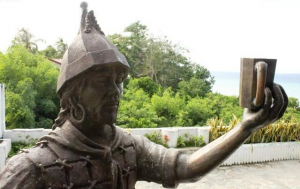PART I: REFORMS AND CONCEPTS
Proem
There were two Maura Laws in the Philippines and hence in Bohol. The First Maura Law was issued on May 19, 1893 and the Second Maura Law was issued on Feb 13, 1894. The First Maura Law affected the form of Municipal Governments in the Philippines and the Second Maura Law affected the issuance of Land Titles in the Philippines. We will consider only the First Maura Law.
First Maura Law
During the Age of Enlightenment in the 18th century the general population in Europe begun to questioned the rules of Kings and the aristocracy.
The first to establish a different form of government was the United States of America. The rules were based in a constitution and the officials were elected. Taking the U.S.A. as the model, the European country of France revolted. The King was deposed and the new form of government was based on the principles of “Equality, Liberty, and Fraternity”. The French people wanted that their form of government and principles will be followed by the people of Europe.
The French people made war against different countries in Europe. Even though the leaders of the French Revolution quarrelled among themselves and killed each other, there soon arose a brilliant military commander that continued to propagate the new French way of thinking. That commander was Napoleon Bonaparte.
From the year 1797 to 1814, Napoleon Bonaparte changed forever the way of thinking in Europe. In the 19th century the reforms continued and near the end of the 19th century the reforms reached the Philippines.
However, when the reforms made by Spain in the Philippines were already too late. The mental set of the Filipinos were already in the verge of revolution.
When the First Maura Law was implemented it created confusion because it was not properly understood by the Filipino people.
From town to municipality
From the start of Spanish colonization the local governments were organized in the concept of a town. The town government (Sp: pueblo) were of two aspects, the religious and the civil. The religious aspect was the parish and headed by the Spanish priest. The civil aspect was the pueblo and headed by the Gobernadorcillo. The religious aspect was superior than the civil aspect.
The civil town officials merely follows the dictates of the Parish Priest. The civil town officials had no power to enact laws and make loans as a juridical person.
Until the date October 2, 1885 the civil officials of the towns in Bohol were, a.) Gobernadorcillo (Mayor), b.) Juez de Ganados (Judge for Cattles), c.) Juez de Sementeras (Judge for Farms), d.) Juez de Policia (Judge for Police), d.) Tenientes (Lieutenants), and f.) Alguaciles (Costables).
The Gobernadorcillo and the four (4) Judges were elected by a few selected electors for a term of one year and later on for a term of three (3) years.
The governing council had no power to enact laws. The taxes and laws were promulgated by the Spanish authorities. The situation was reformed by the Maura Law of 1893.
The reforms
In 1893 the Spanish Minister of Colonies Don Antonio Maura y Montaner, recommended to the Queen Regent Maria Christina the so called “Maura Law of 1893”. It was supposed to be effective in year 1895 but it was revised to be effective in January 1, 1894.
In principle the local government was changed from a Pueblo (Town) to a Tribunal Municipal (Municipal Tribunal). The town head was changed from Gobernadorcillo to Capitan Municipal (Municipal Captain). The next in rank was the Teniente Mayor (Superior Chief) then followed by the Teniente de Policia (Police Lieutenant), Teniente de Sementeras (Lieutenant for Farms), Teniente de Ganados (Lieutenant for Cattles). There were also elected two (2) Suplente or Substitutes.
Aside from the above officials there were also twelve (12) Asesor Natos (Ex-Oficio members) from the principalia (Upper-class of society) that will be part of the Municipal Tribunal but without salaries. The whole Municipal Tribunal was supposed to function like todays Municipal Council with the Capitan Municipal as the presiding officer.
The above officials were elected by secret ballot by six (6) selected Cabeza de Barangays, three (3) former town heads (Gobernadorcillo) and three (3) prominent taxpayers. The local election was supervised by the Provincial Governor with the Parish Priest acting like today’s Commission on Election to proclaim the winner.
As you will note there is no mention of the qualifications of the candidates and the voters. In the “Varias Papeles de Bohol” we have the list of elected officials in Bohol approved by the Provincial Governor Ortiz, dated 2 January 1894.
Consequence
Even though the intention of the reform was laudable it became questionable in actual practice. The Parish Priest is not found in the system of government and naturally he will not agree if the Tribunal will be able to pass laws or ordinances.
The twelve (12) “delegates” or Asesor Natos from the Principalia or upper-class of society were reluctant to participate because they were not paid to do a very delicate and important job.
Next issue we will print the names of the elected local officials of the different towns in Bohol. Strangely, the heading of the list stated the supposed elected officials but the names of the 12 from the Principalia are not included.
It seems that the results of the election for 1894 for a term of four (4) years were not implemented because the listing of local officials for 1898 had a different composition.
It should be noted that by August 1896 the revolution already started in Luzon. Even though the Boholanos did not openly participated in 1896, many Boholanos were already uncooperative to the Spanish government. Only very few paid their cedula.
Even though Nicolas Butalid was elected Capitan for Tagbilaran, the name in official communications carried the name Eduardo Calceta as Gobernadorcillo.


Be First to Comment